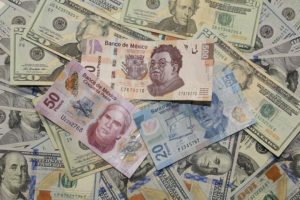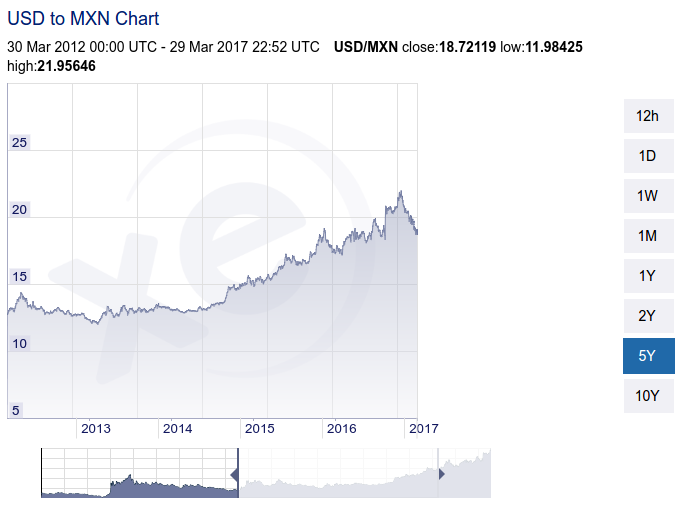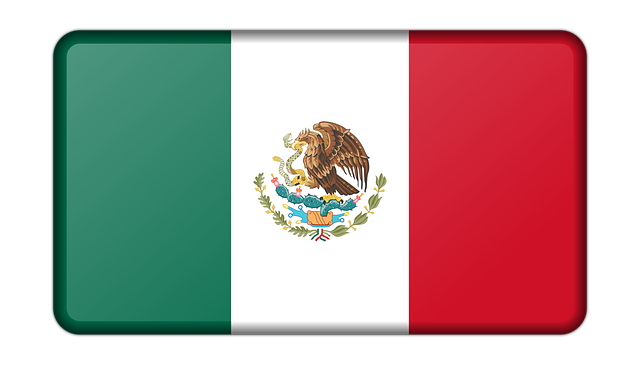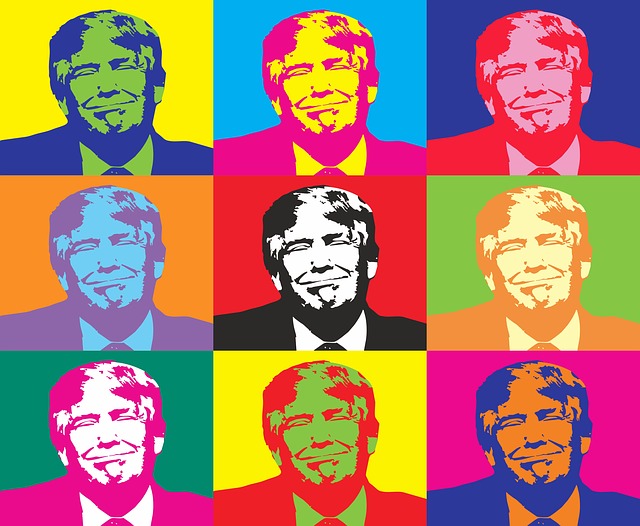The Mexican Peso and You
 The strength of the US dollar ($USD) against the Mexican Peso ($MXN) has been the focus of a great deal of attention over the last year. Plenty of theories have been set forth to explain it, ranging from the cratering of crude oil and other commodity prices to the rhetoric of US Republican President Donald Trump. Conversations about the exchange rate among certain groups on social media exploded last year, while a cursory glance at Google web search trends for “Mexican peso” indicates that over the last 5 years, interest really began growing from 2015 into 2016 with large spikes in April and November of last year. Needless to say, there’s good reason for all the attention the topic has been getting. The exchange rate between the $MXN and the $USD (or other currencies such as the Euro (€EUR)) affects multiple interested parties, from Mexicans both inside and outside of the country to travelers to expats residing in Mexico to multinational corporations and governments looking to do business with Mexico. Why had the $USD/$MXN exchange rate risen so high, and will the dollar continue to stay strong against the peso? Or, will the peso continue to recover as it has been doing recently? In order to answer these questions, we must look at the behavior of both the peso and the dollar separately as well as in relation to each other. It’s important to gain the best possible understanding of the situation, and we’re here to help.
The strength of the US dollar ($USD) against the Mexican Peso ($MXN) has been the focus of a great deal of attention over the last year. Plenty of theories have been set forth to explain it, ranging from the cratering of crude oil and other commodity prices to the rhetoric of US Republican President Donald Trump. Conversations about the exchange rate among certain groups on social media exploded last year, while a cursory glance at Google web search trends for “Mexican peso” indicates that over the last 5 years, interest really began growing from 2015 into 2016 with large spikes in April and November of last year. Needless to say, there’s good reason for all the attention the topic has been getting. The exchange rate between the $MXN and the $USD (or other currencies such as the Euro (€EUR)) affects multiple interested parties, from Mexicans both inside and outside of the country to travelers to expats residing in Mexico to multinational corporations and governments looking to do business with Mexico. Why had the $USD/$MXN exchange rate risen so high, and will the dollar continue to stay strong against the peso? Or, will the peso continue to recover as it has been doing recently? In order to answer these questions, we must look at the behavior of both the peso and the dollar separately as well as in relation to each other. It’s important to gain the best possible understanding of the situation, and we’re here to help.
To start with, we need to get into the correct frame of mind.
Establishing a little structure around the conversation should prove useful. For one, currencies can be thought of as goods to be bought and sold. The US dollar is one, the Mexican peso is another. Additionally, when we talk about the value of a currency, we mean the value with respect to other currencies. What can the peso buy that is denominated in dollars or how many pesos does it take to buy one dollar? In other words, when we talk about the strength or weakness of a currency, we can’t talk about it in a vacuum. We have to discuss it in terms of how it stacks up against its peers.
Also be aware that the dollar didn’t just gain against the peso, it gained against a host of other currencies as well, including the Canadian dollar ($CAD) and the €EUR. Conversely, the peso probably didn’t lose against all other currencies out there in the world; there were probably some other currencies against which it stayed stable or maintained parity with, or some weaker ones against which it quite possibly even gained.
Now, on to some specifics.
Right now, US dollars are in high demand worldwide and have been for some time.

The $USD to $MXN over a five year period. This chart effectively shows how many pesos one dollar purchased over that amount of time.
- People in many countries are selling their local money and buying dollars in order to buy dollar-denominated investments or products. As with anything, when people dump one thing for another, and they do it en masse, it affects the value of those things. One ends up being in plentiful supply, while the other ends up in high demand, and that affects prices.
- US government bonds are still seen as the safest debt instrument investments in the entire world, so people all over the globe continue to convert their local currencies into dollars to buy such safe-haven assets like treasuries as part of their investment portfolios. Doing so helps to decrease the overall risk of a portfolio and guard against the curve balls thrown by an uncertain world.
- The US stock market is seen as a “safe” market to invest in, with “safe” companies that are stable or still growing nicely (think GE and Amazon.com). Again, large investors dump local currencies for dollars in order to invest in such companies.
- What’s more, the Fed is on a path of raising interest rates, and while they haven’t exactly been sprinting to do so, they are somewhat alone in this (other countries have been cutting rates or making no changes at all for years now). Raising rates increases the return on certain dollar-denominated investments like CDs and savings accounts and encourages people to save as opposed to spend, which effectively decreases money in circulation and bolsters the strength of the dollar itself.
- Many Chinese (and others) have been buying up real estate in the US. That means the Chinese are taking their yuan and buying dollars with it, then taking those dollars and buying properties with them. They are essentially selling or dumping their yuan in favor of the dollar. Why? Because China’s economy is a bit of a mess, regulation forces are unpredictable and such “hard” dollar-denominated investments in the US are perceived to be safer than investments in the Chinese stock market or real estate, for example. Plus, as an investor, you know what to expect in the US vs China, regarding market conditions, regulations, participant behavior and so on. That’s worth a lot, and it’s an economic lesson the Chinese government has yet to fully learn.
- The US is one of the only stable, recovering economies in the entire world. As others recognize that and invest in the country and its housing or stock markets or what have you, or actually move to the country to live and work, they convert their local currencies into dollars, driving the value of the dollar up even more.
Pesos, on the other hand, were not in such (clearly) high demand, but that is changing.
- Mexico lost a good deal of its manufacturing to China over the years. This put more pressure on the country to make money from services like tourism, and commodities like oil and metals such as copper, silver and gold. But commodity prices are not what they used to be, to put it gently. Hence, Mexico suffers from a decreased ability to make money from manufacturing or commodities, leaving it with a decreased ability to make money, period. Businesses were getting their manufacturing done elsewhere and oil and minerals fetched less than they used to. This all means that these businesses and investors were not converting their local currencies into pesos at all, or if they were they required less pesos than before to purchase those natural resources. Tourism alone, and the demand for pesos that it provided, could not fill in the entire gap left behind.
- Currency traders can have an impact on the value of currencies as well and they were betting against the peso for the last little while. Some argue that the peso is seen as a stand-in currency for sentiment regarding emerging economies; it’s a barometer of sorts, indicating how the investment community feels about the economic prospects of the developing world. As they speculate on the future of those countries by taking bets via currency trading, they can impact the relative strength of a given currency.
- Mexico may have been undertaking policies to depreciate the peso on purpose, in order to stimulate the economy or invite foreign investment. This is not an uncommon thing for a country to do (the US and others have done it before) and there is plenty of evidence that this works to to stimulate the national economy or attract foreign companies to set up shop in your country as their capital investments in your country, such as manufacturing plants, become cheaper to make and labor costs decrease.
- There’s also something we could call the incompetence argument. This explanation goes that Mexico has made “poor financial decisions” and now has more debt and higher inflation. Just about every country has debt (the US has a ton and yet the economy is doing well), and inflation is a complicated matter that cannot just be pinned on a government administration. Uderstanding a country’s inflationary pressures can prove to be quite complex and require a good deal of analysis. This argument is a bit of a red herring, especially if you keep in mind that a government may want to purposely devaluate its currency in order to invite foreign investment. Returning to the general question of government debt, yes, the debt of many countries is often denominated in US dollars just like the debt of the US (another conversation altogether), getting countries into trouble. They have to dump their own currencies in order to buy dollars to pay their debts, and this gets worse as they incur more national debt at faster and faster rates. There doesn’t seem to be any hard evidence that this happening in Mexico, though, i.e. that Mexico has such staggering debts that they need to dump pesos for dollars at such an alarming rate as to affect the exchange rate. Nor have we seen anything indicating that Mexico is in trouble of not being able to pay off their debts at all, which means investors who hold Mexican bonds are not dumping those peso-denominated securities and negatively impacting the peso’s value.
- Let’s not forget that in the wake of Trump’s visit to Mexico prior to his becoming president, the Finance Minister at the time, Luis Videgaray, was forced out. This means that the whole program was without a captain for a brief period. Markets hate uncertainty, so while he may not have been appreciated, Videgaray’s presence represented some stability. In the absence of someone, anyone, to captain the ship, questions and uncertainty might abound. Who would replace him? Would they be a good choice? What course would they chart? Would they get along with cabinet members? And on and on. Irregardless of everything else, the markets couldn’t possibly know how to feel about the peso and Mexican economics and finance until a new Finance Minister – whom they could evaluate – arrived on the scene.
- Speaking of Trump, some observers claim there is a “Trump effect” taking place. The theory goes that as he bullies companies into investing in the United States as opposed to Mexico (Toyota and Honda have been attacked on this), or threatens to walk away from NAFTA, that this will hurt Mexico’s economic prospects and make it a less attractive country to invest in. More business will be lost if the US slaps tariffs on Mexican exports to the US or twists business’s arms into making capital investments in the US rather than in Mexico. Thus, fewer parties will want to exchange their local currencies for pesos as they avoid investing in the country altogether for fear that their finished products bound for sale in the US will consequently be adversely targeted by Trump & Co.
- In the short term, some businesses may choose caution and refrain from buying pesos and investing in Mexico for now because Mexico’s economic future vis-a-vis the US is unclear at this moment. Instead, they may choose to park their money in US dollar-denominated money markets until political policies become clearer, affecting the exchange rate.
- Nonetheless, Mexico continues to see a bunch of foreign investment from companies from many countries throughout the world right now, and the US remains one of those. That means that these foreign multinationals are dumping their local currencies and buying pesos in order to build factories and other buildings like hotels, rent offices and hire local workers including Mexican IT engineers. This will work in the peso’s favor. Hot industries right now include hospitality, electronics, IT research and auto parts manufacturing.
- Mexican companies are growing and gaining international attention, attracting investment. This includes airlines and technology startups, among many others. This will work in the peso’s favor.
- Exports of products native to Mexico, such as perishables like berries, are big business these days. Certain transportation systems and capacities, such as Guadalajara’s airport and its refrigeration facilities, are already in place to get those perishables to customers like China.
- People from all over the world, including Mexican-Americans with dual citizenship, are choosing to move to and/or retire in Mexico in ever-increasing numbers. Collectively, they are buying pesos with their local currencies as they make the move to finance their lives.
Here are some final thoughts.

While we cannot predict the future, $1 USD bought almost $24 MXN not so long ago. That rose from approximately $12 MXN in April of 2013. It is now sinking quite sharply again and, as of the publication of this article, sits slightly below $19 MXN. The peso has been recovering considerably against the dollar on a nearly daily basis for a little while now, since mid to late January of this year. If we can claim that this is a trend, that new trend is down, in favor of the peso.
What we can currently observe is that the price of crude oil has recovered somewhat, though the price of crude really doesn’t explain away the weakness or strength in the value of the peso as some have claimed. For example, crude has been gaining in price over the last year, while the peso really didn’t begin to firm against the dollar until the start of 2017. Additionally, the Trump administration appears to be softening its stance on doing business with Mexico. Meanwhile, the Bank of Mexico has engaged in a fresh round of currency intervention in order to prop up the peso. This is done by using their store of dollars to purchase pesos. What’s more, there continue to be companies that invest in Mexico, in spite of the Trump administration’s posturing on economic relations with Mexico. Not to mention that political stability in the US is currently tenuous at best, what with congressional and intelligence investigations into the influence of Russia on the elections last year and the country’s communications with the Trump campaign. Should anything come of those investigations, the dollar would be adversely affected. All of this bodes well for the further strengthening and stabilization of the peso against the $USD.
Practically speaking, that means that for folks who convert their local currencies into pesos in order to live in or visit Mexico, you’ll be paying a bit more today than you had been over the last few months in rent, food costs, tours and so on, because while your rent may still be the same amount peso-wise, it currently takes more of your home currency to buy the pesos that you pay your landlady with. However, imports from other countries outside Mexico and priced in pesos might now be a bit cheaper. For those of you outside Mexico, the country’s exports reaching you might now be a bit more expensive. It’s all a give-and-take kind of thing.
No doubt there will be further movement in the exchange rate as the US dollar is still no slouch and many details of our brave new world remain up in the air. We do anticipate an exchange rate that favors the peso, relative to how it has been, but only time will tell what is yet to come. The future, as always, remains unpredictable.



